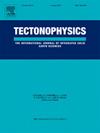Temporal variation in counterclockwise vertical-axis block rotations across a rift overlap zone, southwestern Ethiopia, East Africa
IF 2.7
3区 地球科学
Q2 GEOCHEMISTRY & GEOPHYSICS
引用次数: 0
Abstract
The southward propagation of the southern Main Ethiopian Rift (sMER) and the northward propagation of the Kenya Rift have generated the Broadly Rifted Zone (BRZ), a ∼ 40-km-wide region of extensional overlap between the Chew Bahir Basin-Gofa Province and the sMER. However, the tectonic interaction between these propagating rifts is not well-understood. We present new paleomagnetic and geochronologic data from Eo–Oligocene (45–35 Ma) and Miocene (18–11 Ma) volcanic and sedimentary rocks from the BRZ. Rock magnetic, alternating field and thermal demagnetization experiments indicate simple titanomagnetite mineralogies carrying a characteristic remanent magnetization from which straightforward magnetization directions were obtained. Site-mean paleomagnetic directions obtained from the analyzed samples reflect stable normal and reversed polarity directions. A comparison of the mean directions obtained for the Eo–Oligocene and Miocene rocks relative to the pole for stable South Africa at the corresponding ages reveals a significant counterclockwise (CCW) rotation of ∼11.1° ± 6.4° and insignificant CCW rotation of ∼3.2° ± 11.5°, respectively, reflecting a decrease in the extent of block rotations through time. Our results are consistent with the regional migration patterns of deformation during rifting. In the context of the regional tectonic evolution toward a narrow zone of extension, much of the deformation associated with block rotations probably occurred prior to the final stages of the emplacement of the Miocene volcanic flows. In light of the structural fabrics in the basement rocks exposed in the sMER, the observed CCW block rotations were likely accompanied and aided by the reactivation of NW-SE-striking basement heterogeneities, supporting the notion that inherited crustal-scale structures play a significant role during rifting across the BRZ.
东非埃塞俄比亚西南部裂谷重叠带逆时针垂直轴块体旋转的时间变化
埃塞俄比亚南部主裂谷(sMER)的向南扩展和肯尼亚裂谷的向北扩展形成了宽裂谷带(BRZ),这是一个约40公里宽的区域,位于Chew Bahir盆地- gofa省和大裂谷带之间。然而,这些扩展的裂谷之间的构造相互作用还不是很清楚。本文介绍了BRZ的始渐新世(45-35 Ma)和中新世(18-11 Ma)火山岩和沉积岩的古地磁和地质年代学资料。岩石磁场、交变磁场和热退磁实验表明,简单的钛磁铁矿矿物学具有特征的剩余磁化,从中可以获得直接的磁化方向。从分析样品中得到的古磁极平均方向反映了稳定的正极性和反极性方向。比较稳定的南非在相应年龄的始渐新世和中新世岩石相对于极点获得的平均方向,分别显示出明显的逆时针(CCW)旋转(~ 11.1°±6.4°)和不明显的CCW旋转(~ 3.2°±11.5°),反映出随着时间的推移,块体旋转的程度在减少。研究结果与裂谷期区域形变迁移模式一致。在区域构造向狭窄伸展带演化的背景下,大部分与地块旋转有关的变形可能发生在中新世火山流侵位的最后阶段之前。根据sMER中基底岩石的构造结构,观察到的CCW地块旋转可能伴随着并辅助了北西-东向基底非均质性的重新激活,支持了继承的地壳尺度结构在BRZ裂陷过程中起重要作用的观点。
本文章由计算机程序翻译,如有差异,请以英文原文为准。
求助全文
约1分钟内获得全文
求助全文
来源期刊

Tectonophysics
地学-地球化学与地球物理
CiteScore
4.90
自引率
6.90%
发文量
300
审稿时长
6 months
期刊介绍:
The prime focus of Tectonophysics will be high-impact original research and reviews in the fields of kinematics, structure, composition, and dynamics of the solid arth at all scales. Tectonophysics particularly encourages submission of papers based on the integration of a multitude of geophysical, geological, geochemical, geodynamic, and geotectonic methods
 求助内容:
求助内容: 应助结果提醒方式:
应助结果提醒方式:


